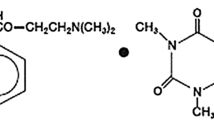Abstract
Matrices are manufactured by direct compression of a powder mixture of a polymer, e.g., methylhydroxypropyl cellulose (MHPC) or polyvinylalcohol (PVAI), and a drug. The following factors that can influence the drug release mode were investigated at constant surface: (i) polymer solution viscosity, glass transition temperature, and swelling; (ii) drug concentration in the matrix and solubility; and (iii) conditions of release experiment (hydrodynamics). In the case of zero-order release profiles (hydrocolloids with low viscosities), only the dissolution of the polymer appears to control the drug release rate. Factors accelerating polymer dissolution resulted in higher release rates. Comparison of swollen and dry hydrocolloid matrices shows that the duration and kinetics of drug release were not controlled by the swelling front moving into the dry polymer, and water penetration and relaxation were not rate controlling. Therefore, the glass transition temperature had no effect on drug release from these hydrocolloids. The higher the hydrodynamic stress exerted on the eroding hydrocolloid, the faster the resulting drug release as a result of accelerated polymer dissolution. With hydrocolloids of very high viscosity the polymer dissolution is slow, and drug relese from the swollen gel appears to be controlled by diffusion according to kinetics of the Higuchi type.
Similar content being viewed by others
REFERENCES
T. Higuchi. Mechanism of sustained-action medication. J. Pharm. Sci. 52:1145–1149 (1963).
S. K. Baveja and K. Padmalatha Devi. Sustained release tablet formulation of metoprolol tartrate. Indian J. Pharm. Sci. 47:78 (1985).
S. K. Baveja, K. V. Ranga Rao, and K. Padmalatha Devi. Zero-order release hydrophilic matrix tablets of β-adrenergic blockers. Int. J. Pharm. 39:39–45 (1987).
P. Catellani, G. Vaona, P. Plazzi, and P. Colombo. Compressed matrices: Formulation and drug release kinetics. Acta Pharm. Technol. 34:38–41 (1988).
P. Colombo, A. Gazzaniga, C. Caramelle, U. Conte, and A. La Manna. In vitro programmable zero-order release drug delivery system. Acta Pharm. Technol. 33:15–20 (1987).
H. E. Huber, L. B. Dale, and G. L. Christenson. Utilization of hydrophilic gums for the control of drug release from tablet formulations. I. Disintegration and dissolution behavior. J. Pharm. Sci. 55:974–976 (1966).
B. Huet de Barochez, J. S. Julien, F. Lapeyre, S. Horvath, and A. Cuiné. Influence of drug solubility in the formulation of hydrophilic matrices. Drug Dev. Ind. Pharm. 15:2197–2212 (1989).
R. W. Korsmeyer, R. Gurny, E. Doelker, P. Buri, and N. A. Peppas. Mechanisms of solute release from porous hydrophilic polymers. Int. J. Pharm. 15:25–35 (1983).
K. V. Ranga Rao, K. Padmalatha Devi, and P. Buri. Influence of molecular size and water solubility of the solute on its release from swelling and erosion controlled polymeric matrices. J. Control. Release 12:133–141 (1990).
J. J. Shah, S. M. Bolton, and A. W. Malick. Hydroxypropylcellulose. Evaluation of effects of various factors on sustained-release characteristics of salicylic acid from compressed tablets. J. Pharm. Sci. 76:S297 (1987).
A. Wermerskirchen. Haftvermögen und Freigabeverhalten von selbsthaftenden Bukkalfilmen in vitro und in vivo, Dissertation, Bonn, 1989.
N. L. Thomas, and A. H. Windle. Case-II-swelling of PMMA sheet in methanol. J. Membr. Sci. 3:337–342 (1978).
A. Urtti, M. Juslin, and O. Miinalainen. Pilocarpine release from hydroxypropyl-cellulose-polyvinylpyrrolidone matrices. Int. J. Pharm. 25:165–178 (1985).
H. B. Hopfenberg, and H. L. Frisch. Transport of organic micromolecules in amorphous polymers. J. Polym. Sci. B7:405–409 (1969).
H. Lapidus and N. G. Lordi. Some factors affecting the release of a water-soluble drug from a compressed hydrophilic matrix. J. Pharm. Sci. 55:840–843 (1966).
R. Anders and H. P. Merkle. Evaluation of laminated mucoadhesive patches for buccal drug delivery. Int. J. Pharm. 49:231–240 (1989).
G. Vankatesh, W. M. Eichkoff, and K. Vishnupad. Studies on mechanism of drug release from monolithic delivery devices. J. Pharm. Sci. 76:S305 (1987).
P. Y. Wang. Controlled release by a combination chemical matrix. Proc. Int. Symp. Control. Release Bioact. Mater. 13:39–40 (1986).
P. I. Lee. Diffusional release of a solute from a polymeric matrix—Approximate analytical solution. J. Membr. Sci. 7:255–275 (1980).
P. I. Lee and N. A. Peppas. Prediction of polymer dissolution in swellable controlled-release systems. J. Control. Release 6:207–215 (1987).
R. S. Harland, A. Gazzaniga, M. E. Sangalli, P. Colombo, and N. A. Peppas. Drug/polymer matrix swelling and dissolution. Pharm. Res. 5:488–494 (1988).
J. Möckel. Mechanismus kontinuierlicher und gepulster Arzneistofffreisetzung aus Hydrokolloideinbettungen, Dissertation, Düsseldorf, 1990.
D. Voegele. Modellierung von Auflöseprofilen mit Hilfe der allgemeinen Exponentialfunktion auf Basis der Momente der Auflösezeiten. Abstract, Vortrags-und Diskussionsveranstaltung des Instituts für Pharmazeutische Technologie der Heinrich-Heine-Universität Düsseldorf, Leinsweiler, 1988.
D. Voegele, D. Brockmeier, and H. M. von Hattinberg. The mean-transit-time as an aid in the development of galenical dosage forms. In N. Rietbrock, B. G. Woodcock, and G. Neuhaus (eds.), Methods in Clinical Pharmacology, Vieweg, Braunschweig, 1980, pp. 94–99.
A. Heyd, D. O. Kildsig, and G. S. Banker. Dissolution of macromolecules. J. Pharm. Sci. 58:586–588 (1969), 59:947–949 (1970).
K. Ueberreiter. The solution process. In J. Crank and G. S. Park (eds.), Diffusion in Polymers, Academic Press, London, 1967, pp. 219–257.
K. Ueberreiter and F. Asmussen. Velocity of dissolution of polymers. J. Polym. Sci. 57:187–208 (1962).
Hoechst AG, Mowiol Polyvinyalkohol, Company Information, 1984.
H. P. Merkle, Untersuchungen an Einbettungen von Arzneistoffen in Polyvinylpyrrolidon, Habilitationsarbeit, Heidelberg, 1979.
H. Nogami, T. Nagai, and A. Kondo. Dissolution kinetics of polyvinylpyrrolidone of various molecular weights. Chem. Pharm. Bull. 18:2290–2296 (1970).
Author information
Authors and Affiliations
Rights and permissions
About this article
Cite this article
Möckel, J.E., Lippold, B.C. Zero-Order Drug Release from Hydrocolloid Matrices. Pharm Res 10, 1066–1070 (1993). https://doi.org/10.1023/A:1018931210396
Issue Date:
DOI: https://doi.org/10.1023/A:1018931210396




